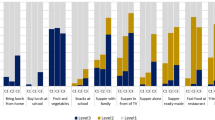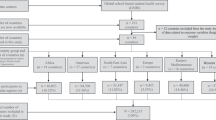Abstract
Objective: To investigate nutrition-related habits of Greek school-aged adolescents.
Design: Epidemiological survey.
Setting and subjects: The study was part of the Health Behavior in School Aged Children (HBSC) survey. A representative sample of school-aged adolescents aged 11.5, 13.5, and 15.5 y was obtained. The final sample consisted of 4211 students (51.6% girls and 48.4% boys). They were asked to complete a translated form of the international HBSC questionnaire, including several thematic entities. The Unhealthy Food Choices Score (UFCS) was devised in order to evaluate the overall quality of reported eating habits of respondents; the higher the score, the lower the diet quality.
Results: Among all students surveyed, 14.7% were reported to be on a diet to lose weight (girls: 19.5%; boys: 9.7%; P<0.001), and 22.9% were dissatisfied with their body weight but not on a diet. Girls were found to have lower UFCS values compared to boys (24.7±4.6 vs 24.1±4.5, P<0.001). Girls dissatisfied with their weight, but not on a diet, showed the highest UFCS values compared to both those on a diet and those not on a diet. TV viewing was positively associated with the consumption of sodas, crisps, cakes and pastries, and sweets and chocolates.
Conclusions: Dieting is becoming a major problem, especially among older girls. The findings of this study suggest that eating habits of Greek school-aged adolescents are in the process of changing from more traditional to more Westernized ones.
This is a preview of subscription content, access via your institution
Access options
Subscribe to this journal
Receive 12 print issues and online access
$259.00 per year
only $21.58 per issue
Buy this article
- Purchase on Springer Link
- Instant access to full article PDF
Prices may be subject to local taxes which are calculated during checkout



Similar content being viewed by others
References
Amorim Cruz JA (2000): Dietary habits and nutritional status in adolescents over Europe—Southern Europe. Eur. J. Clin. Nutr. 54(Suppl 1), S29–S35.
Andersen LF, Nes M, Sandstad B, Bjorneboe GE & Drevon CA (1995): Dietary intake among Norwegian adolescents. Eur. J. Clin. Nutr. 49, 555–564.
Basiotis PP, Carlson A, Gerrior SA, Juan WY & Lino M (2002): The Healthy Eating Index 1999-2000. US Department of Agriculture, Center for Nutrition Policy and Promotion. Washington, D.C.
Booth ML, Okely AD, Chey T & Bauman A (2001): The reliability and validity of the physical activity questions in the WHO health behaviour in schoolchildren (HBSC) survey: a population study. Br. J. Sports Med. 35, 263–267.
Cade J, Thompson R, Burley V & Warm D (2002): Development, validation and utilisation of food-frequency questionnaires—a review. Public Health Nutr. 5, 567–587.
Cole TJ, Bellizi MC, Flegal KM & Dietz WH (2000). Establishing a standard definition for child overweight and obesity worldwide: international survey. BMJ 320, 1240–1243.
Currie C, Hurrelman K, Settertobulte W, Smith R & Todd J (2000): Health and Health Behaviour among Young People. Health behavior in School aged children: A WHO Cross National Study (HBSC). Copenhagen: Health Promotion and Investment for Health, WHO Regional Office for Europe.
Dietz WH (1998): Health consequences of obesity in youth: childhood predictors of adult disease. Pediatrics 101, 518–525.
Edmunds H & Hill AJ (1999): Dieting and the family context of eating in young adolescent children. Int. J. Eat. Disord. 25, 435–440.
Emmons L (1996): The relationship of dieting to weight in adolescents. Adolescence 31, 167–178.
Fraser GE, Welch A, Luben R, Bingham SA & Day NE (2000): The effect of age, sex, and education on food consumption of a middle-aged English cohort-EPIC in East Anglia. Prev. Med. 30, 26–34.
Gregory J, Lowe S, Bates C, Prentice A, Jackson LV, Smithers G, Wenlock R & Farron M (2000): National Diet and Nutrition Survey: Young People Aged 4 to 18 Years. Volume 1: Report of the diet and nutrition survey. London: The Stationery Office.
Haines PS, Siega-Riz AM & Popkin BM (1999): The Diet Quality Index revised: a measurement instrument for population. J. Am. Diet. Assoc. 99, 697–704.
Hasapidou MN & Fotiadou E (2001): Dietary intakes and food habits of adolescents in Northern Greece. Int. J. Food Sci. Nutr. 52, 109–116.
Herbold NH & Frates SE (2000): Update of nutrition guidelines for the teen: trends and concerns. Curr. Opin. Pediatr. 12, 303–309.
Hill AJ & Franklin JA (1998): Mothers, daughters and dieting: investigating the transmission of weight control. Br. J. Clin. Psychol. 37, 3–13.
Hill AJ, Oliver S & Rogers PJ (1992): Eating in the adult world: the rise of dieting in childhood and adolescence. Br. J. Clin. Psychol. 31, 95–105.
Hill AJ (1993): Causes and consequences of dieting and anorexia. Proc. Nutr. Soc. 52, 211–218.
Huon GF & Walton CJ (2000): Initiation of dieting among adolescent females. Int. J. Eat. Disord. 28, 226–230.
Inchley J, Todd J, Brycet C & Currie C (2001): Dietary trends among Scottish school children in the 1990s. J. Hum. Nutr. Diet. 14, 207–216.
Karayiannis D, Yannakoulia M, Terzidou M, Sidossis LS & Kokkevi A (2003): Prevalence of overweight and obesity in Greek school-aged children and adolescents. Eur. J. Clin. Nutr. 57, 1189–1192.
Lien N, Jacobs Jr DR & Klepp KI (2002): Exploring predictors of eating behaviour among adolescents by gender and socio-economic status. Public Health Nutr. 5, 671–681.
Lytle LA, Himes JH, Feldman H, Zive M, Dwyer J, Hoelscher D, Webber L & Yang M (2002): Nutrient intake over time in a multi-ethnic sample of youth. Public Health Nutr. 5, 319–328.
Lytle LA, Seifert S, Greenstein J & McGovern P (2000): How do children's eating patterns and food choices change over time? Results from a cohort study. Am. J. Health Promot. 14, 222–228.
Paulus D, Saint-Remy A & Jeanjean M (2001): Dietary habits during adolescents – results of the Belgian Adolux Study. Eur. J. Clin. Nutr. 53, 130–136.
Pirouznia M (2001): The association between nutrition knowledge and eating behavior in male and female adolescents in the US. Int. J. Food Sci. Nutr. 52, 127–132.
Popkin BM (1994): The nutrition transition in low-income countries: an emerging crisis. Nutr. Rev. 52, 285–298.
Rolland-Cachera M-F, Bellisle F & Deheeger M (2000): Nutritional status and food intake in adolescents living in Western Europe. Eur. J. Clin. Nutr. 54(Suppl 1), S41–S46.
Roma-Giannikou E, Adamidis D, Gianniou M, Nikolara R & Matsaniotis N (1997): Nutritional survey in Greek children: nutrient intake. Eur. J. Clin. Nutr. 51, 273–285.
Samuelson G (2000): Dietary habits and nutritional status in adolescents over Europe: an overview of current studies in the Nordic countries. Eur. J. Clin. Nutr. 54(Suppl 1), S21–S28.
Shepherd R & Dennison CM (1996): Influences on adolescent food choices. Proc. Nutr. Soc. 55, 345–357.
Stookey JD, Wang Y, Ge K, Lin H & Popkin BM (2000): Measuring diet quality in China: the INFH-UNC-CH Diet Quality Index. Eur. J. Clin. Nutr. 54, 811–821.
Story M, Neumark-Sztainer D & French S (2002): Individual and environmental influences on adolescent eating behavior. J. Am. Diet. Assoc. 103(Suppl 3), S40–S51.
Story M, Neumark-Sztainer D, Sherwood N, Stang J & Murray D (1998): Dieting status and its relationship to eating and physical activity behaviors in a representative study of US adolescents. J. Am. Diet. Assoc. 98, 1127–1135.
Suitor CW & Cleason PM (2002): Using Dietary Reference Intake-based methods to estimate the prevalence of inadequate nutrient intake among school-aged children. J. Am. Diet. Assoc. 102, 530–536.
Supreme Scientific Health Council (SSHC), Ministry of Health and Welfare (1999): Dietary Guidelines for Adults in Greece. Arch. Hell. Med. 16, 516–524.
Taylor CB, Sharpe T, Shisslak C, Bryson S, Estes LS, Gray N, McKnight KM, Crago M, Kraemer HC & Killen JD (1998): Factors associated with weight concerns in adolescent girls. Int. J. Eat. Disord. 24, 31–42.
Thomas J (1991): Food choices and preferences of schoolchildren. Proc. Nutr. Soc. 50, 49–57.
U.S. Department of Agriculture (USDA) (2000): Report of the Dietary Guidelines Advisory Committee on the Dietary Guidelines for Americans, 2000. Washington, DC: USDA.
Vereecken C & Maes L (2000): Eating habits, dental care and dieting. In Health and Health Behaviour among Young People, ed. C Currie, K Hurrelmann, W Settertobulte, R Smith, J Todd, pp 83–95. Copenhagen: World Health Organization Regional Office for Europe.
Weaver CM, Peacock M & Johnston CC Jr (1999). Adolescent nutrition in the prevention of postmenopausal osteoporosis. J. Clin. Endocrinol. Metab. 84, 1839–1843.
Yannakoulia M, Matalas A-L & Grivetti LE (2003). From frugality to disordered eating behavior. The case of Greece. In Eating Disorders in the Mediterranean World. Cognitive and Sociocultural Correlates, ed GM Ruggiero. Huntington, NY: NOVA Publisher.
Author information
Authors and Affiliations
Contributions
Guarantor: LS Sidossis.
Contributors: MY and DK carried out data handling and analysis. MY drafted the paper. AK was the principal investigator and MT was the scientific coordinator of the Greek HBSC study; both of them assisted in the interpretation of data. LSS contributed to the interpretation of data and to the writing of the paper.
Corresponding author
Rights and permissions
About this article
Cite this article
Yannakoulia, M., Karayiannis, D., Terzidou, M. et al. Nutrition-related habits of Greek adolescents. Eur J Clin Nutr 58, 580–586 (2004). https://doi.org/10.1038/sj.ejcn.1601849
Received:
Revised:
Accepted:
Published:
Issue Date:
DOI: https://doi.org/10.1038/sj.ejcn.1601849



